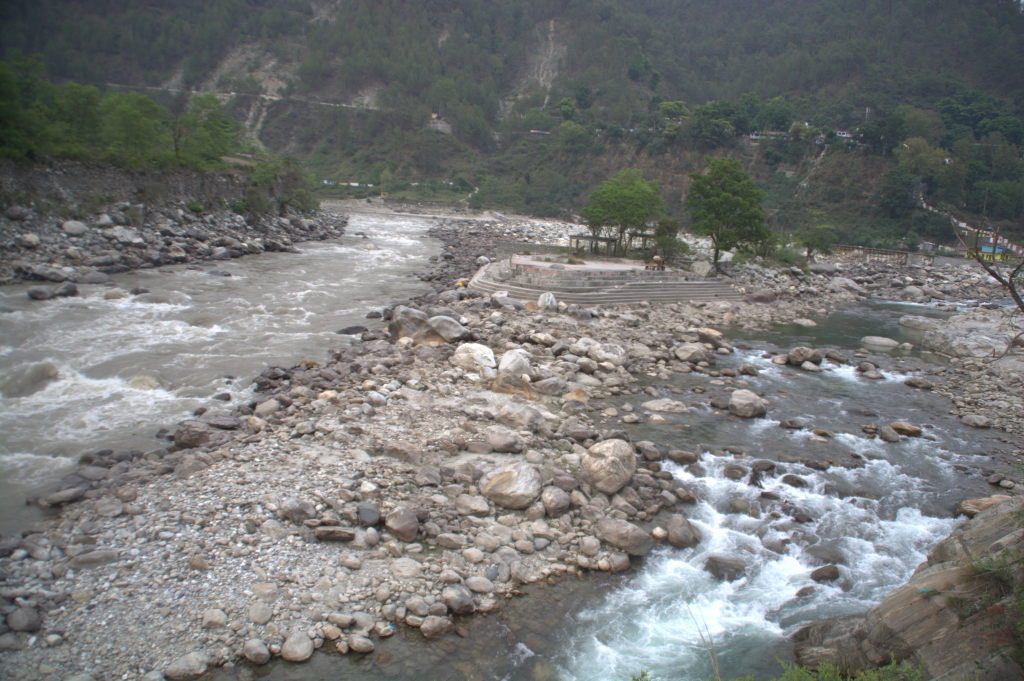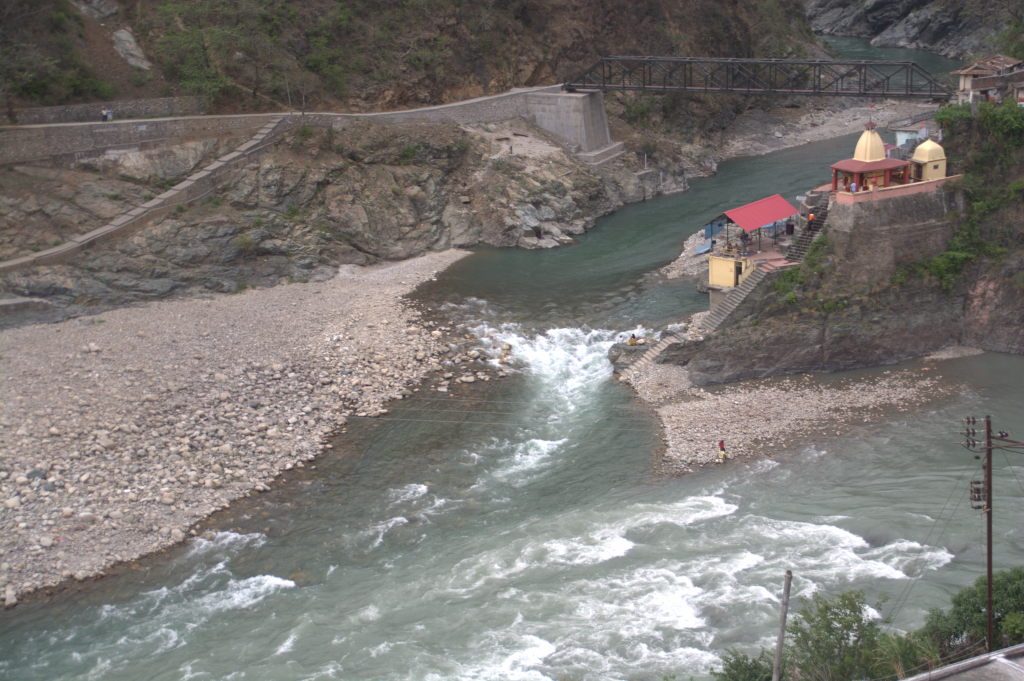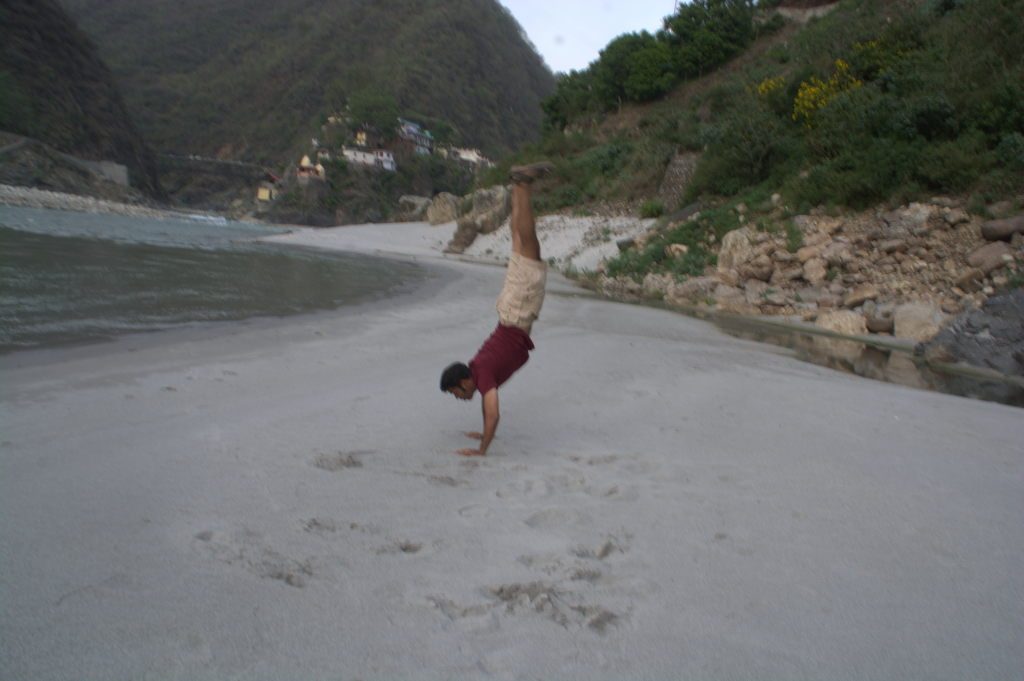In Uttarakhand state, the towns of Rishikesh and Haridwar are the only towns that see Ganga river in its entirety. To their east, several towns see the tributaries that make up the mighty river. Several rivers make up India’s longest river — a river that is considered a Goddess or a mother figure by the Hindus. The three major rivers that play the biggest part are Alaknanda, Bhagirathi and Mandakini. All of them are in the Garhwal region, the region that forms the northern half of the state of Uttarakhand. At the origin of these three rivers are three holy pilgrimages which are part of Uttarakhand’s Char Dham (the 4 abodes): Badrinath, Kedarnath and Gangotri. The fourth Dham is Yamnotri, which is the source of Yamuna river. Yamuna plays no part in the Ganga river system within Uttarakhand, in fact not before Prayagraj in Uttar Pradesh. So let’s ignore Yamuna for this post. We’ll come back to Her in another post.
Along with three of the four Dhams, there are 5 more places that are holy for a different purpose. These are the places where the major tributaries join forces to form a bigger river. These places are known as Prayags or Sangams. Since there are 5 holy unions, they are collectively termed as the Panch Prayag. In relation to the Char Dham, the 5 Prayags are less known, but they make up extremely beautiful destinations. Let’s go on a beautiful and interesting journey, following the tributaries of river Ganga and pause at the places where She joins other rivers and becomes a bigger river. We will have a closer look at each of the 5 Prayags.
This post as a video
You can watch the contents of this blog post as a video here.
Alaknanda river starts

Alaknanda river flowing through Badrinath.
Let’s start at the eastern-most point of Ganga’s trip. At Mana glacier, on the icy slopes above Badrinath, where India’s mountains rub shoulders with those of China’s, the Alaknanda river starts. While the people of India come to Badrinath for religious reasons, its true importance is as the source of Alaknanda. In fact, this is true for all the Dhams and Prayags. These places are important to religion because of geological/geographical importance. In India, science, geography and religion go hand-in-hand. Badrinath is the place where the Alaknanda river bed takes shape as the water from the surrounding glaciers join forces and set course as one. The biggest rivulet is from the Mana glacier and hence that is considered the official origin of the Alaknanda river. Since we will cover Badrinath in detail in a seperate post about Char Dham, let’s move on to focus on the Prayags. We will travel from east to west.
Vishnu Prayag

Dhauli Ganga joins Alaknanda at Vishnu Prayag.
The Dhauli Ganga river flows from the south of Badrinath from the slopes of Niti Pass in Chamoli district. It meets the Alaknanda river at Vishnu Prayag. Vishnu Prayag is apparently the least significant of the Prayags, given the footfall. At the Prayag, there is just a viewpoint and a small temple that overlooks the confluence. It is situated conveniently: right on the highway from Joshimath to Badrinath, on the Rishikesh – Badrinath Highway. But you will hardly see tourists lining up for the view here, especially during the off-season. There are no lodges, no restaurants and no taxi stands at Vishnu Prayag. Buses do not have the space to park here since the road bends into a hairpin right where the Prayag’s viewpoint is. If you are on your way to Badrinath by a private taxi or by your own vehicle, you can park on the curb and visit the viewpoint. You could get off here using public transport. But then that transport will move on, leaving you behind and you will be forced to wait for the next one. During the off-season, that all-important ‘next bus’ or ‘next Sumo’ is elusive.
Nand Prayag

Alaknanda (left) and Nandakini (right) with the Prayag viewpoint in the centre.
The Nandakini river (with an N, not to be confused with Mandakini) joins Alaknanda after flowing from the lower slopes of Nandadevi range of mountains, which is at the border of India and Nepal. To see the confluence, one takes a long winding staircase that descends from the Rishikesh – Badrinath highway passing through town and leads to a small delta that overlooks the confluence of the two rivers. Nandakini is a really narrow river. But Alaknanda, flowing from Badrinath and already having built plenty of momentum is a raging mass. The sound of the confluence can be heard throughout the day and can be a soothing effect as you relax in a cosy lodge inside the town.
Nand Prayag is populated enough to be a town with lodges and restaurants. However, there is no official taxi stand or a bus terminal. A shared Sumo plying between Karna Prayag and Joshimath or an Uttarakhand state transport bus plying between Haridwar / Rishikesh and Joshimath can drop you off here. Similar transport can be used to leave town as well.
A good place to stay at Nandprayag is at a lodge named Kedar-Badri Samiti Dharamshala. The rooms belong to a religious, non-profit trust affiliated to the Kedarnath and Badrinath temples, so profit is not their chief motive. We got a room for as low as ₹ 300.
KarnA Prayag

At Karnaprayag confluence. Left (south): Pindar, right (east): Alaknanda.
The river Pindar, after melting from the Pindari glacier adjacent to the Nandadevi range in the Kumaon region, flows north and meets Alaknanda at the busy town of Karn Prayag. A temple with a small staircase takes us to a bed of pebbles on the eastern bank of the confluence of the two rivers. Each river is straddled by a highway bridge.
Karn Prayag is an important town and a vital junction in Uttarakhand. The Rishikesh – Badrinath highway runs parallel to the Alaknanda river. Another highway starts at Karn Prayag, stays with the Pindar river and enters the Kumaon region via the town of Gwaldam. From here, one can go to Kausani, Almora and Nainital, popular hill stations in the Kumaon mountains since the British era.
Karn Prayag can be called the gateway between Garhwal and Kumaon regions of Uttarakhand. As a result, travelling to Karn Prayag is quite easy. It is a major stop on the highway between Rishikesh and Badrinath. Plus, you can travel from a Kumaoni cities like Almora. Due to this reason, buses halt here for 15-20 minutes, allowing people plenty of time to interchange buses. Taxis are also aplenty, as are restaurants and lodges.
Rudra Prayag

View of the Alaknanda (right) – Mandakini (left) confluence and the Rudranath temple.
Rudra Prayag is the second most important confluence in Uttarakhand. It is the confluence of two rivers coming from two important Dhams in the Char Dham Yatra. The river Mandakini flowing from Kedarnath in the north joins the Alaknanda river flowing from Badrinath in the east. The confluence is marked by the Rudranath temple. A beautiful lodge named the Baba Kaali Kamli Wala Dharamshala is situated on the bank of the confluence opposite the temple. There is a beautiful view of the confluence from this lodge, enhanced by the constant music of the two rivers bouncing on rocks and joining each other.
Also interesting at this confluence is the long stretch of a river beach on the southern bank of Alaknanda. Similar river beaches can be seen at Rishikesh. You can spend an entire evening on this beach, having fun on the sand. Every dawn and dusk, a Ganga Aarti prayer takes place at the Rudranath temple.

River beach at Rudra Prayag
Rudra Prayag is a very busy town and a very major highway junction. The Rishikesh – Badrinath highway that stays parallel to the Alaknanda river is met by the Rudra Prayag – Gupt Kashi highway. This latter highway goes all the way to a village named Gauri Kund, which is the starting point for the Kedarnath trek. Rudra Prayag is a perfect transit hub to switch transport during a sight-seeing tour that covers both Kedarnath and Badrinath.
Dev Prayag

Alaknanda flows from the left (east) and joins forces with Bhagirathi (the clearer blue river on the right coming from the north) and flows towards the south (right) as Ganga.
Dev Prayag is India’s second-holiest river confluence, second only the to Ganga – Yamuna Sangam at Prayagraj. At Dev Prayag, the river Alaknanda is joined by river Bhagirathi. The latter rushes in from the icy slopes of Gangotri from the northern direction.
Bhagirathi is considered the mother river even though its contribution to the confluence in terms of volume of water is just 1/3rd. Also, the length of Bhagirathi in kilometres is significantly less than that of Alaknanda. However, the faster and the more turbulent current of Bhagirathi deflects the path of the confluence towards its direction. It appears that the longer and more voluminous, yet calmer Alaknanda is submitting to the strength of the smaller and shorter Bhagirathi river, which is more forceful and energetic. Even the name of the source, Gangotri (the source of Ganga), suggests that Bhagirathi is the more important river. This is also confirmed by the Hindu story of sage Bhagirath’s penance to Goddess Ganga, who is believed to be a celestial river. According to that story, the Goddess from heaven becomes a terrestrial river on earth and first touches the ground at Gangotri.
In all other confluences, the river Alaknanda gets to keep Her name after the confluence. The names Dhauli Ganga, Nandakini, Pindar and Mandakini vanish. But at Dev Prayag, neither Alaknanda nor Bhagirathi gets to retain Her name. Beyond the confluence, the river is called Ganga. This is the name by which the whole world knows Her. This is the sacred name by which She flows through important cities like Rishikesh, Haridwar, Roorkee, Varanasi, Prayagraj, Patna and all the way to Farakka in West Bengal. Beyond Farakka, She crosses into Bangladesh, where She peacefully gives away her water to the Bay of Bengal.
Beyond…

The amazing orchestration of the evening time Ganga Aarti at Rishikesh’s Triveni Sangam
Rishikesh is the first major city in the combined river’s path where you get to see Ganga river in Her full glory and strength. It is also the first city on the course of the river where She is celebrated, worshipped and revered by every household. One look at the evening time Aarti at the city’s Triveni Sangam is a goose-bump inducing experience. It says all about the river’s importance to Rishikesh, Uttarakand and all of India.
Here is a video of the entire Ganga Aarti performance at Rishikesh.
ConClusion
The Ganga river system is complex, but it is also intriguing. The river’s hypnotising energy casts a spell on you. The hypnotism is magnified when you stand at the very places where multiple rivers run into each other with boundless energy from the high slopes of the Garhwal mountains, only to smooth out and flow with a motherly calm that beautifully matches Her name Gange Mata, as she makes Her way through some of India’s holiest towns, enriching them with fertile soil, wealth, flora, fauna, history and culture.


Pingback: Geography: Understanding Garhwal and Kumaon regions of Uttarakhand | India 360